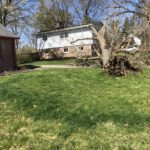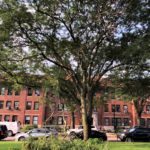Recently, there was another tragic accident at a camp involving a tree failure in which people were severely injured and one girl died from the results of this tree falling in a storm. We frequently hear about tree issues involving damage to vehicles or homes often causing people to be injured, or worse.
Tree care professionals are frequently asked, “is my tree safe?” It could literally be a million-dollar question and one that should not be taken lightly or answered without due diligence to protect the tree owner. The simple answer is no. Every tree has a risk of failure, but the benefits of trees far exceed the risks.
We need trees for our health and quality of life. Trees provide a wide variety of benefits which include shade, cleaner air and water, carbon sequestration, and sociological benefits. These benefits increase as the age and size of the trees increase. However, as trees get older and larger, they may become more likely to shed branches or develop decay or other conditions that can increase the likelihood for failure.
It is impossible to maintain trees free of all risk; some level of risk must be accepted to experience the benefits that trees provide. The risk to humans is extremely low; according to statistics, there is a 1 in 20 million chance of being injured by a tree falling. However, because tree owners have a legal duty of care, it is the responsibility of the owner to be aware of the condition of their trees on their property.
- Tree failures are often predictable and preventable.
- Broken branches can occur at any time during severe storms even on healthy trees.
Landowners often become more aware of tree issues and risk situations after a weather event such as windstorm, ice or flooding. It is natural for trees to lose branches during storms, even on healthy trees. However, many of the tree failures, either whole tree or in part are predictable and often times, preventable. Regular assessments during the year, especially after a weather event helps to identify risk issues. Also, regular inspections for health to determine if the tree is predisposed to branch failure or windthrow is prudent to help reduce the likelihood of failure. During an inspection, if a tree presents a situation where there is a suspected increased risk of failure, it is the tree’s owner who must make the decision about whether that risk is unacceptable. However, if you are unable to make an informed decision, it would be advised to consult a qualified arborist.
Generally speaking, the law obligates landowners to periodically inspect their property and take reasonable care to maintain it so as to not pose a risk of harm to others. As a result, if they fail to identify and mitigate dead or dangerous trees and harm results, they can be held liable for that harm. However, property owners are not responsible for the unforeseeable results of storms or other weather events, if the trees appear healthy. The term “Acts of God” relate to events outside human control and may limit or eliminate liability for injuries or loss.
Landowners and homeowners should take precautions to reduce the potential for harm on their properties. It is wise to carry insurance coverage and to have your trees periodically inspected by a certified arborist or consulting arborist, especially if you believe your trees may be at risk of failure. Regular tree inspections help to reduce risk and keep them vigorous and growing to make our world greener, happier and healthier.
Find a certified arborist; https://www.treesaregood.org/findanarborist
Find a consulting arborist; https://www.asca-consultants.org/search/custom.asp?id=3818
Trees and Storms, FNR-FAQ-12-W; https://mdc.itap.purdue.edu/item.asp?Item_Number=FNR-FAQ-12-W



